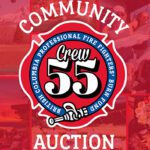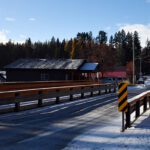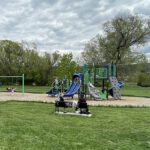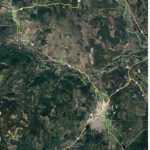Home »

Deer culling issue on full boil
Anyone who lives in the East Kootenay who has open eyes and does lots of driving and gardening knows they are a problem.
Everyone wants something to be done.

But that’s where commonality of opinion regarding the urban deer issue seems to end.
The City of Cranbrook was the first of three municipalities in the region to obtain a Ministry of Forests, Land and Natural Resource Operations permit to cull 25 mule or whitetail deer from herds within the city boundaries.
Contractor Carmen Purdy began setting clover traps on Dec. 6 and two weeks later he was finished.

Next up are the City of Kimberley and District of Invermere, each permitted to cull 100 deer from within their boundaries.
That was the tipping point for some folks in the region, who argue that culling is not the way to go. Each of the three municipalities given the green light to trap and exterminate (using a bolt gun) deer formed legislation and directions based on urban deer committees.
Kimberley began its cull January 3 and by Jan. 9 Mayor Ron McRae was reporting that 25 animals had been killed. That night, at Kimberley’s regular meeting of council, the Humane Treatment of Urban Wildlife Committee (HTUW), with members in the three culling communities and elsewhere, including Grand Forks which is also conducting a cull, appeared to ask council to halt the cull.
Council voted to send the request to the city’s Operations Committee, but the cull continues.

The next night, HTUW’s interim chair Colleen Bailey also appeared before District of Invermere council to introduce the group and also request for a suspension of culling activity.
“We are a newly formed grassroots East Kootenay organization focused on working with communities on finding humane solutions for urban wildlife management,” Bailey told council, adding, “I want to acknowledge that we understand that the appearance of our group expressing interest in Invermere’s urban deer management method may be a bit frustrating for current council at this time.”
“I assure you, had we known or understood the proposed method to be employed, and the ramifications of the proposed solution, we would have been involved sooner. Our founding membership was unaware of the culls

or processes until the Cranbrook cull made the news in December and a concerned citizen contacted us. It was at that time, the founding members of Humane Treatment of Urban Wildlife began its research recognizing that the Kimberley and Invermere culls were impending. As such, we needed to understand the process, the science and the ramifications.
“With that, I am writing you as a representative of not only Humane Treatment of Urban Wildlife, but also for your constituents who have expressed concerns. We are respectfully asking council to postpone the Invermere urban deer cull,” Bailey asked, adding, “Through our independent research we have discovered that critical information, which could have assisted your decision making ability, may have been overlooked. This information could change the outcome of the review and decision of whether or not to perform a cull, and whether or not to use the clover trap/bolt gun method.”
Bailey pointed out that culls are ineffective “as shown by the Compensatory Rebound Effect, which has been observed in studies conducted by the University of Tennessee, the United States Department of the Interior Fish and Wildlife Services and documented in the Journal of Wildlife Management.
“Clover net and bolt guns are an inhumane method of killing deer,” Bailey continued, pointing out that a 1997 scientific study that demonstrated deer that were immobilized and killed using a captive bolt gun “exhibited blood cortisol levels that were 10 times higher than deer killed by rifle shot. Blood cortisol, excreted by the adrenal glands under conditions of duress, is considered by scientists to be an accurate measure of an animal’s physiological and psychological stress.
“The BCSPCA is opposed to the inhumane culling of urban deer and encourages the use of non-lethal strategies to address urban deer issues for the long-term. Culling is only a temporary solution and should not be used as the default management practice when communities are experiencing high deer population levels and increased deer-human conflict,” Bailey stated.
“We are asking council to postpone the deer cull decision in order to provide us more time to review and audit all information related specifically to the Invermere urban deer situation, management methods and to then have time to present our findings to the current Deer Committee and council,” she concluded.
Invermere council voted to continue with the cull but added a cancellation clause at 10 deer as a precautionary measure.
Like Cranbrook and Kimberley councils, the decision to enact the cull did not come easy.
 Invermere Mayor Gerry Taft said he’s been hearing all sides in the last few years, since the notion of culling first began to do the municipal council rounds in the region, and believes the most heated opposition is coming from outside the East Kootenay.
Invermere Mayor Gerry Taft said he’s been hearing all sides in the last few years, since the notion of culling first began to do the municipal council rounds in the region, and believes the most heated opposition is coming from outside the East Kootenay.
“There was some opposition, with one lady comparing me and council to Hitler and the Nazis killing Jewish people,” he exclaimed, adding, “Over the last couple of days we have received quite a few emails from animal rights groups based in Vancouver and elsewhere asking us to stop or delay any consideration of the cull.
“There was some discussion by council about whether or not we had enough information to proceed with the decision. Councillor (Spring) Hawes stated that she was not comfortable with this being annual or normal management practice, but was willing to consider this as a trial. Coun. (Justin) Atterbury expressed concern for the safety of children in the community and spoke in favour of proceeding,” Taft said, adding, “I personally feel, based on the time and effort we have spent analyzing the information, this is the right decision to partner with the province and to try this technique of dealing with habituated urban deer, and then measure where this was effective or not.”
‘Conditional’ support has been the order of the day for most elected officials, who have stated they don’t like the idea of a cull but something must be done to address the growing problem.
“I think that the boom in deer herds in urban areas, including Invermere, is caused by a range of human induced pressures resulting from the encroachment of urban development into rural and wild areas. Although this is a very challenging situation, we can improve our land development practices to ensure the protection of viable open spaces and the development of vibrant and sustainable communities from this point forward. This will not, however, address the immediate situation,” said District of Invermere Coun. Paul Denchuk.
“I believe that the increased deer herds in Invermere have created two very concerning issues: public safety resulting from aggressive, habituated animals, and the risk of disease spreading through the herd and putting all ungulates in the valley at risk. For these reasons I am conditionally supportive of the deer cull, as long as we can determine that it is in fact humane,” he said.
By committing to be present for the euthanization of the first 10 deer, I believe council can move forward with great integrity on the decision to either continue with the cull or put a stop to it. Also, a cull is not the final answer – we must also bear responsibility for our own role in the herd’s expansion. It is imperative that council and the community follow through on all of the other recommended actions as well, or we will simply find ourselves back in this position one year from now, which would be an unacceptable outcome. Education and bylaw enforcement about not feeding the deer, more rigorous land use planning, and a collaborative approach to wildlife management are required. And I cannot think of a better time to consider an urban containment boundary for Invermere. If we concentrate our development efforts on the town that we have instead of expanding and growing outward we can limit the effects we have on our natural surroundings and the wildlife that inhabit it,” Denchuk said.
Coun Spring Hawes also provided her viewpoint: “While the idea of killing the deer is very upsetting to me, and I dislike it very much, I did vote in support of the cull. Here’s why: As a result of a high number of complaints and concerns raised by residents of Invermere, a Deer Committee was formed, made up of councillors, volunteers, and a rep from the B.C government. They were tasked with researching all aspects of the urban deer population issue, including health and safety considerations, monitoring, and best practices. After months of work, the committee presented their report.
“I respect and appreciate the time, effort and knowledge that went into that report. I believe its findings are rational, well-thought-out and balanced. (For the record, although I didn’t sit on that committee, I did take the time to attend some of the meetings and read much, if not all, of the background information they referred to.) I supported the adoption of the report, with a qualifying statement that I support the report, and its seven recommendations, as a complete document – not a ‘thumbs up’ to do a cull and stop there. I have repeated that statement at every opportunity, including the All Candidate’s Forum,” Hawes said.
“I do not believe culling is an ethical, sustainable way to manage an urban deer population,” she continued, adding, “I have supported it as a one-time intervention, and only as a single component to a multi-pronged approach. In response to Councillor Denchuk’s motion, I have made a personal commitment to observe the actual clover net and bolt gun process, in order to judge the humaneness of it for myself. To be clear, I am dreading that day. I am not a hunter. I’ve never killed anything (other than spiders), and doubt very much that I could. I only buy meat from sources I trust – no feedlots or slaughter house factories.
“I absolutely sympathize with those who are upset by this action. I am too. If I used only my emotions to make decisions, I would have voted otherwise. However, I believe in using my rational brain, too. I don’t think it would be responsible to disregard the information and knowledge included in the deer report, based solely on my emotional response. That being said, this is the one, and only, cull that I will support. I will push very hard to begin implementation of the other, non-lethal recommendations immediately, in order to manage the deer population in a sustainable way,” Hawes stated.
Meanwhile, it seems the Elk Valley’s three municipalities are steering clear of the issue of urban deer, thus far, though Fernie has held discussions.
“The city has not taken any position with respect to urban deer in Fernie. It was the topic of some discussion amongst council members at the last meeting (January 9) but that did not result in any position statement or direction from the council,” offered city chief administrative officer Allan Chabot.
On Jan. 10, e-KNOW asked on its Facebook page: “Deer culling: right or wrong? What is your view? Right or wrong? Tell us.”
The following are comments received
Shelly Shaw stated: “Moved to Cranbrook just when the deer ‘problem’ hit the news. Cannot stress enough how disturbing I find this ‘culling.’ It shames me to think that my adopted home town would do this. Part of living here is the beauty of the place and the wildlife. Have been in extreme close contact with both deer and other wildlife here with no problems. I show the wildlife the respect it deserves and in return I get untold joy from it. Have had a doe give birth in my front yard. Stayed inside, watched and saw nature at its very best. Stop this senseless killing of animals; instead embrace what you have. If you don’t like wild life perhaps a move to the coast is in your future. See how you like the ‘wildlife’ down there.”
Robin Nering Goldsbury added, “Humans have been hunting (essentially culling) deer for a very long time. We have now anthropomorphized the animal kingdom (i.e. Bambi) and failed to realize natural cycles, food chains and balance. If the problem was rats, I’m sure many would have no offence to culling. It would be great if the meat and hides could be put to good use.”
While Prevea Art & Imports noted, “I have no problem with the cull, however, I have not heard of any viable plan that will prevent this from happening again. What are they going to do to stop future deer from becoming ‘urbanized;’ do they have a plan? If the plan is we will just keep killing all deer that come into town then I would not support it.”
If you have something to say about deer culling in the region – please send in a letter to the editor to: [email protected].
Ian Cobb/e-KNOW







